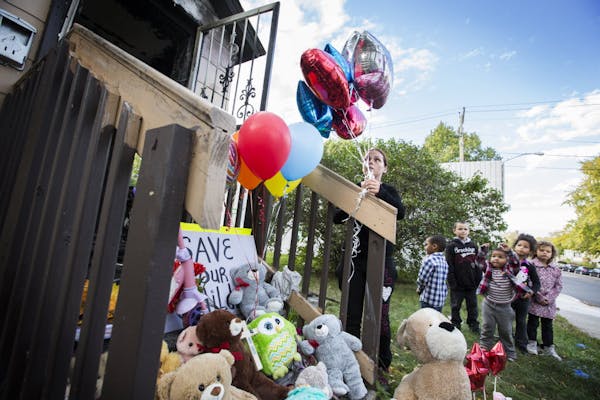Emergency vehicles were clogging the South St. Paul street as Chanry Soeng arrived home after working the second shift at a Lakeville packaging plant.
When she realized they were at her house, she sprinted toward the door, demanding to see her children.
First responders restrained her, then delivered terrible news: her husband, Soeun Sem, 60, and the couple's youngest son, 2-year-old Eric, had died in the fire. Their older boy, 5-year-old Alexander, had been taken to Regions Hospital in St. Paul, but would not survive the night.
An investigation would show that the Oct. 13 blaze began in the garage, where propane cooking equipment often was used to prepare food. Smoke inhalation was ruled the cause of death.
It marked the second multiple-fatality house fire in the Twin Cities area that month, coming only one week after three children under age 7 died in north Minneapolis. Unattended cooking and heating, the causes linked to both incidents, are the leading culprits for residential fires in Minnesota.
Fire-related deaths have spiked this year, claiming 52 Minnesotans, compared with 44 in 2014, according to data from the state fire marshal. On the heels of yet another fatal fire Thursday night in north Minneapolis, officials are warning residents about fire safety during the holiday season, as some of the most dangerous weeks for residential blazes still lie ahead.
"Almost all of these [fatal fires] are 100 percent preventable," said St. Paul Fire Chief Tim Butler. "That's the tragedy when we see things happen: If they were to just follow some simple prevention efforts and had operating smoke alarms, they would have survived."
Although fire fatalities have dropped by half since the early 1980s — a downward trend authorities largely credit to the prevalence of smoke alarms and fire safety education — there have been two years since 2000 when the death toll surpassed 52.
Fire departments throughout Minnesota are required to submit data to the State Fire Marshal's Office, where they are compiled for a yearly report. It's too soon to tell what may have caused this year's uptick, but at least three multiple-fatality fires may be a contributing factor, said Fire Marshal Bruce West.
"We want to see, is this just an anomaly type of year, or is there some sort of trend happening?" he said. "Unfortunately, we've had more tragedies this year than last year."
Lethal inattention
Winter months are particularly hazardous because of what West calls holiday staples: cooking, heating and open flames. As families scurry to prepare meals, entertain guests and combat the cold, they can become careless. Candles left burning in an empty home. Space heaters on full blast next to a blanket. Gas burners running unattended.
All are recipes for nearby combustibles to ignite and engulf a room within minutes.
"When you cook, stay and look — that's what we're telling people," Butler said. "People get distracted, they get busy, they walk away from the stove, and pretty soon a grease fire starts."
Beyond being more cautious, officials cite simple home improvements residents can make to drastically reduce the risk of fire. Those cooking on an electric stovetop can "virtually eliminate" kitchen fires by buying a conversion tool called a Safe T Element, Butler said, which keeps temperatures below the auto-ignition point of grease and oil. Gas ranges can also be equipped with canister extinguishers that dump a dry chemical after fire starts.
The fire season
When temperatures dip below freezing across Minnesota, authorities brace for a rash of heating-related fires.
Investigators determined that an electric stove caused the October fire in north Minneapolis that killed three small children after their mother turned it on to heat the home because the furnace was on the fritz. If cooking elements are improperly used to keep warm, there's a good chance something close by will accidentally catch fire, experts say.
Open flames from candles present a similar problem, often knocked over by a pet or child — or simply burning unattended. Fabric from clothing, bedding or even a couch within a 3-foot radius of the flame is an easy target.
Holidays, with the greater use of candles, always pose a bigger threat. Christmas trees should be watered daily to prevent excessive drying and reduce the chance of an electrical fire from the lights.
"Some of these natural trees that dry out can literally become a flaming torch in less than a minute," Butler said. "It's truly amazing; they're explosively combustible."
The cause of Thursday's deadly fire in north Minneapolis, the state's most recent, has yet to be determined. However, the 82-year-old victim and his wife "were both smokers," Minneapolis' assistant fire chief Bryan Tyner said Friday. "They had incense burning, and I'm not sure if there were candles or not."
Though the cause of many fire deaths remains undetermined, careless smoking is the leading cause, claiming at least seven lives this year alone.
Officials are combating these root causes with fire safety education held early and often. Anecdotal evidence has shown the lifesaving effectiveness of preparing even elementary-age students.
A grown colleague of Butler's remembers hearing a fire prevention tip at her grade school during a junior fire marshal event. She went home and demanded that her parents develop an exit strategy in case of an emergency. A fire ignited in their home the very next day.
"All five of the children, the mom and the dad got out because they had practiced the drill," Butler said. "We don't know which tip is going to save a family."
Liz Sawyer • 612-673-4648
Protesters briefly clash at dual pro-Israel, pro-Palestinian rallies at the University of Minnesota

Defense attorneys in Feeding Our Future trial cast doubt on FBI's meal fraud investigation

Overdose deaths spike after incarceration, but Minnesota jails lack treatment

